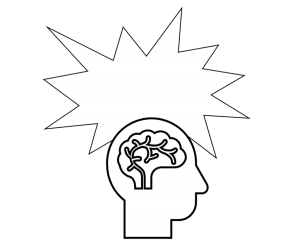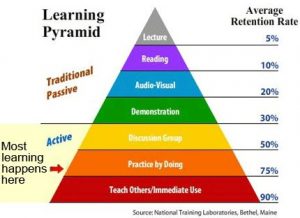
I presented the following 10 research findings at the Rascals Conference in St-Hyacinthe, Quebec, on June 4th, 2018. The handout is here. Get the error correction card game that I described. The PowerPoint and references are below. I have created a web version of the talk that I gave and uploaded it to YouTube so that if you missed my talk or want to share these mind-blowing findings with your colleagues, you can. I have included 9 x 2-minute discussion questions to stimulate discussion and help you supercharge the ESL pedagogy in your at your school. Please share and comment. It is difficult to improve without feedback, so please let me know how I could improve my talk.
Research Findings
1. Teachers are inept and deluded (Kruger & Dunning, 1999).
- More than 90% of teachers think that they are above average (Cross, 1977).
- Teachers are inept at recognizing our ineptitude because we don’t know what we don’t know and because we interpret the absence of complaints as a success.
- We underestimate how long it takes to learn skills we ourselves have mastered.
- We overestimate what our colleagues and students know.
2. Effect-size indicates that some interventions work much better than others, despite what teachers believe.
- Smaller class sizes (20-30 students) learn more than class sizes of about 80 (d=0.21) because smaller classes permit group work and more feedback on classroom behaviors (Hattie, 2009).
- Computer-assisted learning (d=0.37) is 75% more effective at improving student performance than a smaller class size because of the volume of timely feedback it can deliver (Hattie, 2009).
3. Firing 10% of the worst teachers will dramatically improve education (d=75) and stimulate the economy (Hanushek, 2011).
- Firing 8% of the worst teachers in the U.S. would raise the level of education to that of Finland.
- Replacing an average teacher with an above average teacher adds $400 000 of value to the economy every year based on calculations of derived demand.
4. Degrees and experience have no effect on teacher quality
- Degrees and experience have no effect on teacher quality (Hanushek, 2011).
- Teacher quality only improves in the first 3-5 years of a teacher’s career unless other measures are taken.
5. Teacher quality is best improved by making 3 changes to the way you teach:
- video-recording your teaching to watch and analyze for improvements (d=0.88)
- maximizing the clarity of your feedback by refining your instructions and explanations (d=0.75)
- and developing good student-teacher relationships (d=0.72)
6. Teachers routinely sabotage student learning:
- Using textbooks and lessons with irrelevant colour pictures compete with the text for the student’s attention and activate the wrong schema, making new information irretrievable (Harp & Mayer, 1997; Mayer, Heiser, & Lonn, 2001).
- Over-emphasizing formal registers in courses for non-fluent (100 & 101) learners reduces integrative motivation when those students are placed in informal social situations (Segalowitz, 1976).
- Prioritizing argumentation and debate in ESL reduce interest-based motivation to speak, group cohesion, and therefore group productivity (Poupore, 2014).
- Prioritizing argumentation instead of narratives in courses for business students leaves them unprepared for the most common business communication tasks in corporations (Jameson, 2001).
- Teaching the 5-paragraph essay encourages anti-scientific thinking (Berggren, 2008), and its overemphasis at college leaves students unprepared for the range of writing tasks they will face in the workplace and university—and teaching only the 5-paragraph essay has a deskilling effect on teachers (Moss, 2002).
- Failing to align objectives, instruction, and evaluation tasks reduces achievement by up to two standard deviations (Cohen, 1987). The failure to align CEGEP ESL courses is most evident in the continued use of discrete-item grammar tests and academic writing tasks to test a range of verb tenses. Academic writing contains only a high frequency of simple present verbs (Biber et al., 1999). In contrast, narrative writing tasks containing quoted speech can reliably elicit modals, simple present, present continuous, simple past, past continuous, present perfect, and future (will and be going to).
7. Disciplinary removal is ineffective at teaching the social curriculum (Skiba & Peterson, 2003).
- The social curriculum is more effectively taught through presentation of positively framed rules, practice, and feedback, and by using colleagues to communicate expectations to students
8. Production (even silent mouthing) enhances explicit recall better than silent study (McCleod et al., 2010).
- Circling, underlining, and highlighting have only a small effect on explicit recall compared to saying words aloud, miming, drawing, or mouthing words.
- Therefore, we can expect that online quizzes done silently are likely to be a less efficient method for learning new vocabulary than playing an interactive flashcard game with other students. Why? Because saying the clue and answer aloud exploits the production effect, which has been shown to enhance recall by about 10% for each oral repetition.
9. Reciprocal teaching has one of the largest effects (d=74) on student learning (Hattie, 2009).

- Getting students to teach each other has three times the effect of smaller classes. Rather than trying to reduce the student to teacher ratio further, it is much better to get the students to take turns teaching each other by leading discussions on weekly readings. The effect comes not so much from the pedagogical skills of students but from their desire to master the material when it is their turn to teach.
10. Self-reporting grades (d=1.44) and formative exams (d=0.90) have the biggest impact on student learning of all the interventions reported in the scientific literature (Hattie, 2009).
- Simply getting students to predict their score on an exam makes them work harder to achieve that score. Self-reporting grades is a kind of goal setting activity that has about twice the effect size of reciprocal teaching.
- The second best classroom intervention imvolves giving formative exams. Getting forewarning about one’s performance on an exam allows the student to concentrate on areas of weakness that were not visible to them before.
PowerPoint Presentation
References
Berggren, A. (2008). Do Thesis Statements Short-Circuit Originality in Students’ Writing? In Originality, Imitation, and Plagiarism: Teaching Writing in the Digital Age. Ann Arbor, MI: University of Michigan Press. Retrieved from http://dx.doi.org/10.3998/dcbooks.5653382.0001.001
Biber, D., S. Johansson, G. Leech, S. Conrad and E. Finegan (1999), Longman grammar of spoken and written English. Harlow: Pearson Education.
Cohen, S.A. (1987). Instructional alignment: Searching for a magic bullet. Educational Researcher, 16, 16-20.
Cross, P. (1977). Not can but will college teaching be improved? New Directions for Higher Education, 17, 1-15.
Duxbury, A. R. (2008). Speaking my mind: the tyranny of the thesis statement. NCTE English Journal, 97(4). Retrieved from http://www.ncte.org/journals/ej/issues/v97-4.
Hanushek, E. A. (2011). “The economic value of higher teacher quality”. Economics of Education Review 30: 466-479.
Harp, S. F., & Mayer, R. E. (1997). The role of interest in learning from scientific text and illustrations: On the distinction between emotional and cognitive interest. Journal of Educational Psychology, 89, 92-102.
Hattie, J. A. C. (2009). Visible learning: A synthesis of over 800 meta-analyses relating to achievement. London, UK: Routledge.
Jameson, D. (2001). Narrative discourse and management action. Journal of Business Communication, 476-511.
Kruger, Justin; Dunning, David (1999). “Unskilled and Unaware of It: How Difficulties in Recognizing One’s Own Incompetence Lead to Inflated Self-Assessments”. Journal of Personality and Social Psychology. American Psychological Association. 77 (6): 1121–1134.
Mayer, R. E., Heiser, J., & Lonn, S. (2001). Cognitive constraints on multimedia learning: When presenting more material results in less understanding. Journal of Educational Psychology, 93, 187–198.
MacLeod, C. M., Gopie, N., Hourihan, K. L., Neary, K. R., & Ozubko, J. D. (2010). The production effect: Delineation of a phenomenon. Journal of Experimental Psychology: Learning, Memory, and Cognition, 36(3), 671-685.
Moss, G. (2002). The five-paragraph theme. The Quarterly, 24(3). Retrieved from https://www.nwp.org/cs/public/download/nwp_file/467/The_Five-Paragraph_Theme.pdf?x-r=pcfile_d
Poupore, G. (2014). The influence of content on adult L2 learners’ task motivation: An interest theory perspective. Canadian Journal of Applied Linguistics: 17, 2: 69-90.
Segalowitz, N. (1976). Communicative incompetence and the non-fluent bilingual. Canadian Journal of Behavioural Science, 8(2), 121-131.
Skiba, R. & Peterson, R. (2003). Teaching the social curriculum: School discipline as instruction. Preventing School Failure, 47(2), 66-72.
